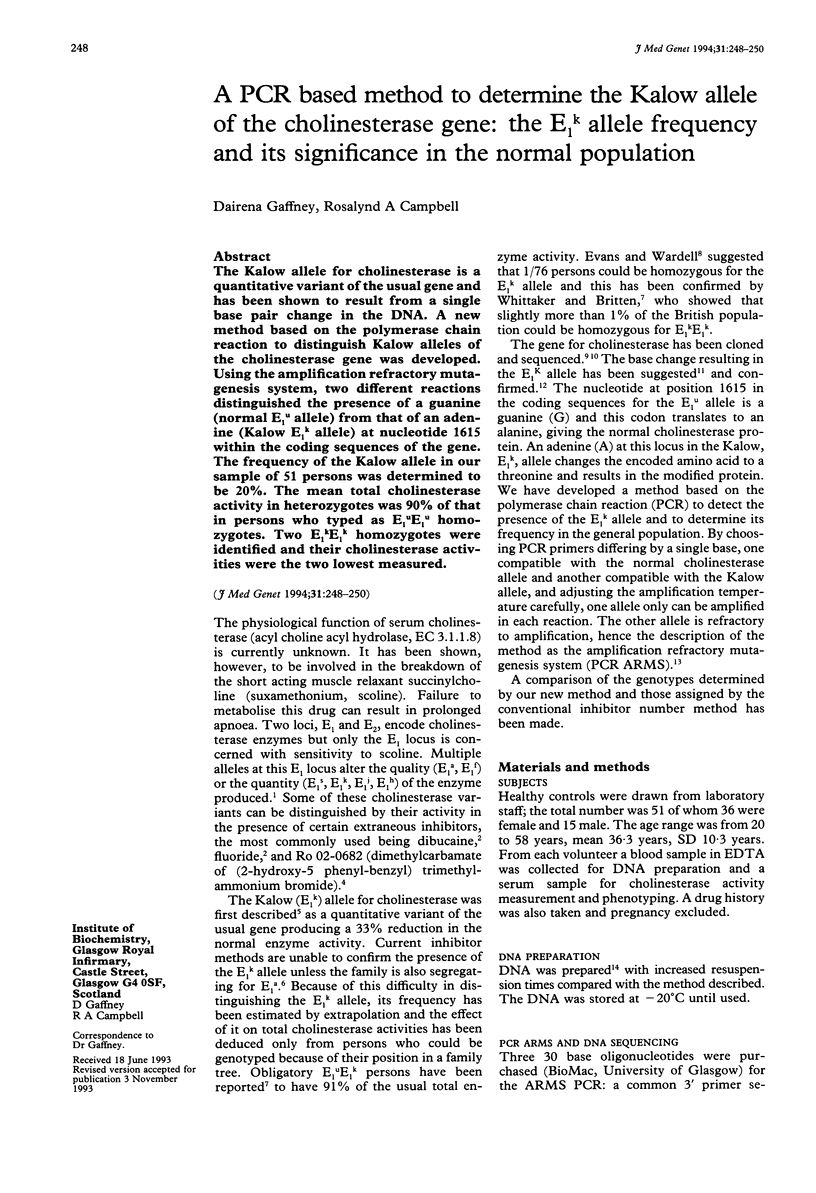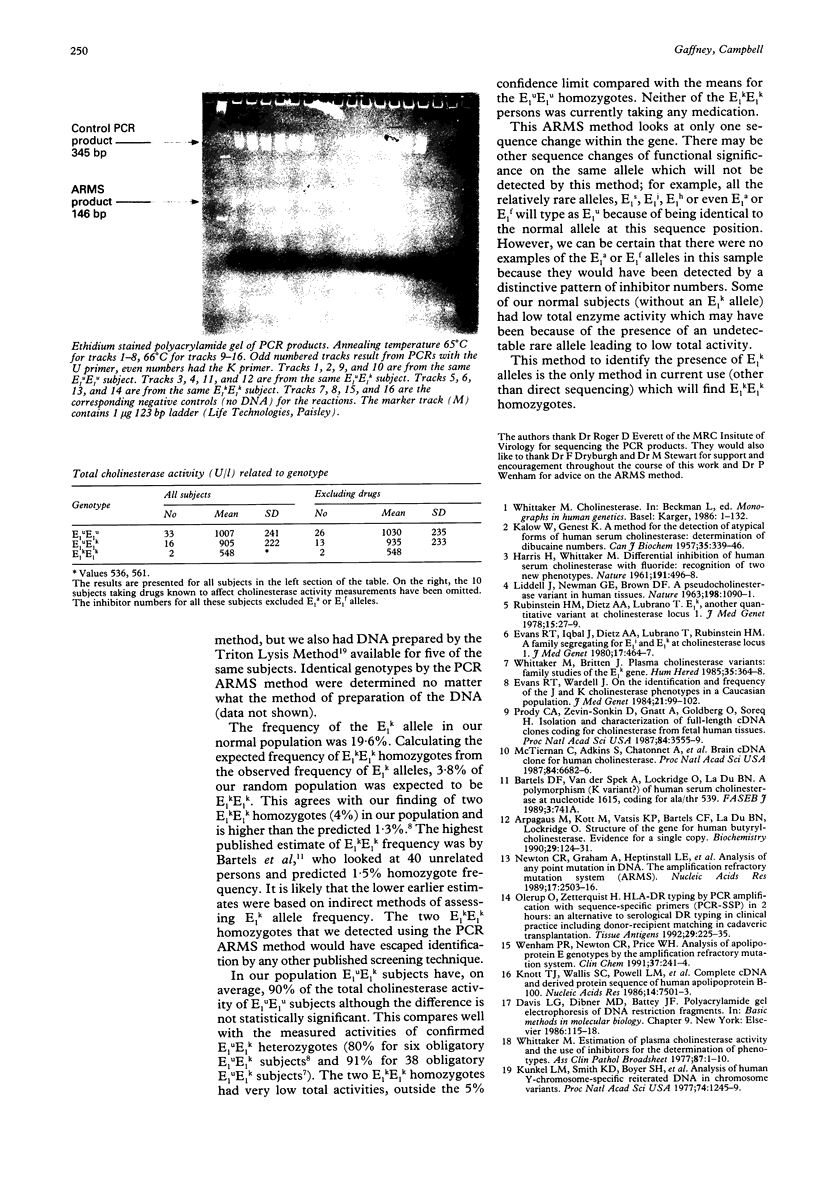Abstract
The Kalow allele for cholinesterase is a quantitative variant of the usual gene and has been shown to result from a single base pair change in the DNA. A new method based on the polymerase chain reaction to distinguish Kalow alleles of the cholinesterase gene was developed. Using the amplification refractory mutagenesis system, two different reactions distinguished the presence of a guanine (normal E1u allele) from that of an adenine (Kalow E1k allele) at nucleotide 1615 within the coding sequences of the gene. The frequency of the Kalow allele in our sample of 51 persons was determined to be 20%. The mean total cholinesterase activity in heterozygotes was 90% of that in persons who typed as E1uE1u homozygotes. Two E1kE1k homozygotes were identified and their cholinesterase activities were the two lowest measured.
Full text
PDF


Images in this article
Selected References
These references are in PubMed. This may not be the complete list of references from this article.
- Arpagaus M., Kott M., Vatsis K. P., Bartels C. F., La Du B. N., Lockridge O. Structure of the gene for human butyrylcholinesterase. Evidence for a single copy. Biochemistry. 1990 Jan 9;29(1):124–131. doi: 10.1021/bi00453a015. [DOI] [PubMed] [Google Scholar]
- Evans R. T., Iqbal J., Dietz A. A., Lubrano T., Rubinstein H. M. A family segregating for E1j and E1k at cholinesterase locus 1. J Med Genet. 1980 Dec;17(6):464–467. doi: 10.1136/jmg.17.6.464. [DOI] [PMC free article] [PubMed] [Google Scholar]
- Evans R. T., Wardell J. On the identification and frequency of the J and K cholinesterase phenotypes in a Caucasian population. J Med Genet. 1984 Apr;21(2):99–102. doi: 10.1136/jmg.21.2.99. [DOI] [PMC free article] [PubMed] [Google Scholar]
- HARRIS H., WHITTAKER M. Differential inhibition of human serum cholinesterase with fluoride: recognition of two new phenotypes. Nature. 1961 Jul 29;191:496–498. doi: 10.1038/191496a0. [DOI] [PubMed] [Google Scholar]
- KALOW W., GENEST K. A method for the detection of atypical forms of human serum cholinesterase; determination of dibucaine numbers. Can J Biochem Physiol. 1957 Jun;35(6):339–346. doi: 10.1139/y57-041. [DOI] [PubMed] [Google Scholar]
- Knott T. J., Wallis S. C., Powell L. M., Pease R. J., Lusis A. J., Blackhart B., McCarthy B. J., Mahley R. W., Levy-Wilson B., Scott J. Complete cDNA and derived protein sequence of human apolipoprotein B-100. Nucleic Acids Res. 1986 Sep 25;14(18):7501–7503. doi: 10.1093/nar/14.18.7501. [DOI] [PMC free article] [PubMed] [Google Scholar]
- Kunkel L. M., Smith K. D., Boyer S. H., Borgaonkar D. S., Wachtel S. S., Miller O. J., Breg W. R., Jones H. W., Jr, Rary J. M. Analysis of human Y-chromosome-specific reiterated DNA in chromosome variants. Proc Natl Acad Sci U S A. 1977 Mar;74(3):1245–1249. doi: 10.1073/pnas.74.3.1245. [DOI] [PMC free article] [PubMed] [Google Scholar]
- LIDDELL J., NEWMAN G. E., BROWN D. F. A pheudocholinesterase variant in human tissues. Nature. 1963 Jun 15;198:1090–1091. doi: 10.1038/1981090a0. [DOI] [PubMed] [Google Scholar]
- McTiernan C., Adkins S., Chatonnet A., Vaughan T. A., Bartels C. F., Kott M., Rosenberry T. L., La Du B. N., Lockridge O. Brain cDNA clone for human cholinesterase. Proc Natl Acad Sci U S A. 1987 Oct;84(19):6682–6686. doi: 10.1073/pnas.84.19.6682. [DOI] [PMC free article] [PubMed] [Google Scholar]
- Newton C. R., Graham A., Heptinstall L. E., Powell S. J., Summers C., Kalsheker N., Smith J. C., Markham A. F. Analysis of any point mutation in DNA. The amplification refractory mutation system (ARMS). Nucleic Acids Res. 1989 Apr 11;17(7):2503–2516. doi: 10.1093/nar/17.7.2503. [DOI] [PMC free article] [PubMed] [Google Scholar]
- Olerup O., Zetterquist H. HLA-DR typing by PCR amplification with sequence-specific primers (PCR-SSP) in 2 hours: an alternative to serological DR typing in clinical practice including donor-recipient matching in cadaveric transplantation. Tissue Antigens. 1992 May;39(5):225–235. doi: 10.1111/j.1399-0039.1992.tb01940.x. [DOI] [PubMed] [Google Scholar]
- Prody C. A., Zevin-Sonkin D., Gnatt A., Goldberg O., Soreq H. Isolation and characterization of full-length cDNA clones coding for cholinesterase from fetal human tissues. Proc Natl Acad Sci U S A. 1987 Jun;84(11):3555–3559. doi: 10.1073/pnas.84.11.3555. [DOI] [PMC free article] [PubMed] [Google Scholar]
- Rubinstein H. M., Dietz A. A., Lubrano T. E1k, another quantitative variant at cholinesterase locus 1. J Med Genet. 1978 Feb;15(1):27–29. doi: 10.1136/jmg.15.1.27. [DOI] [PMC free article] [PubMed] [Google Scholar]
- United Nations. Economic and Social Commission for Asia and the Pacific ESCAP. Population Division. United Nations. Department of International Economic and Social Affairs. Population Division. International Population Information Network POPIN ESCAP/POPIN Working Group on Development of Population Information Centres and Network: report on the meeting held from 20 to 23 June 1984. POPIN Bull. 1984 Dec;(6-7):99–102. [PubMed] [Google Scholar]
- Wenham P. R., Newton C. R., Price W. H. Analysis of apolipoprotein E genotypes by the Amplification Refractory Mutation System. Clin Chem. 1991 Feb;37(2):241–244. [PubMed] [Google Scholar]
- Whittaker M., Britten J. J. Plasma cholinesterase variants. Family studies of the E1k gene. Hum Hered. 1985;35(6):364–368. doi: 10.1159/000153581. [DOI] [PubMed] [Google Scholar]



